Fairs and Festivals
Biraja Kṣetra or modern Jajpur is regarded as the synthesized cultural centre of Odisha. Apart from general festivals connected with other religious faiths observed throughout Odisha. Specific festivals are celebrated in the precients of temple in honour of Goddess Biraja throughout the year. The worship of the goddess Biraja in her various manifestations encompass a host of festivals and ceremonies which have contributed to enrich the cultural fabric of the region. Śākta-Tantric rituals are the basic principle behind all the festivals admitting the Brahmanical method of worship. The important festivals celebrated in the Biraja temple are enumerated below.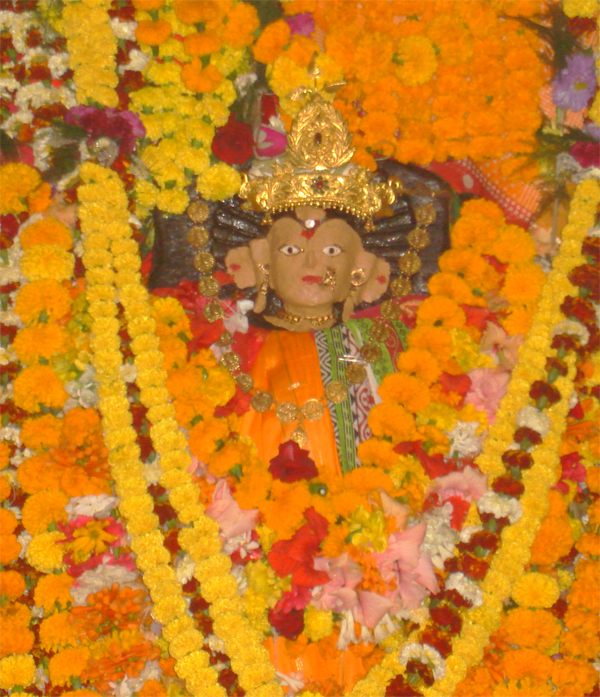
Triveni Amāvāsyā- Triveni Amāvāsyā or the birth day ceremony of goddess Biraja is one of the most important festivals observed in temple. The day comes in the month of Māgha(January-February) on the new – moon day. On account of her birthday she is decorated as Goddess Sāvitri, the consort of Brahama(the creator) with golden ornaments. She is exclusively attired in yellow and worshipped with Gayātri mantra prescribed in the Brahma-Tantra.
Dola Purṇimā -
Dola Purṇimā is observed on the full-moon day of the month of fālguna (february-march) On this occasion, the representative 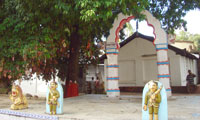 deity is taken in a Vimana (chariot) to Dolavedi(pedestal)in the temple premises in the evening after certain rituals. After the required rites of worship (pūjāniti), the Goddess is sprinkled with fagu or the sacred red powder. Then the astrologer of the Temple opens and recites the new almanac for the year. People gather in large numbers to see the chaceri of Dola yatra and listen to the prescriptions of the new almanac read out.
deity is taken in a Vimana (chariot) to Dolavedi(pedestal)in the temple premises in the evening after certain rituals. After the required rites of worship (pūjāniti), the Goddess is sprinkled with fagu or the sacred red powder. Then the astrologer of the Temple opens and recites the new almanac for the year. People gather in large numbers to see the chaceri of Dola yatra and listen to the prescriptions of the new almanac read out.
Vāruṇi Festival -
Vāruṇi, an auspicious day comes in the month of Caitra(March-April)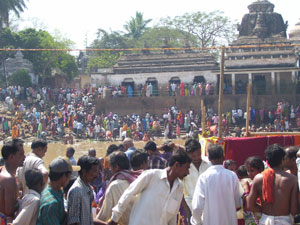 that attracts pilgrims from all over India for sacred ablution in the Vaitaraṇī Satabhiśā, the 24th asterism of the constellation is otherwise known as ‘Varuna’. If the thirteenth day of the dark fortnight of caitra is conjoined with Varuṇa, The day becomes sacred for a bath in the holy river. So the day is called “Vāruṇi”. On this occasion Goddess Biraja is bathed with the holy water of the Vaitaraṇī and a special worship is performed. Hindu Vaishnavite pilgrims come from nook and corner of India and abroad to take a holy dip in the river Vaitaraṇī near Daśāśvamedha Ghāta and offer piṇḍas to their ancestors there and Nābhigayā. They have a holy darshan of Goddess Biraja.
that attracts pilgrims from all over India for sacred ablution in the Vaitaraṇī Satabhiśā, the 24th asterism of the constellation is otherwise known as ‘Varuna’. If the thirteenth day of the dark fortnight of caitra is conjoined with Varuṇa, The day becomes sacred for a bath in the holy river. So the day is called “Vāruṇi”. On this occasion Goddess Biraja is bathed with the holy water of the Vaitaraṇī and a special worship is performed. Hindu Vaishnavite pilgrims come from nook and corner of India and abroad to take a holy dip in the river Vaitaraṇī near Daśāśvamedha Ghāta and offer piṇḍas to their ancestors there and Nābhigayā. They have a holy darshan of Goddess Biraja.
Mahāviśuva Samkrānti - On the first day of the solar month of Vaiśakha (April-May) Mahāviśuva Samkrānti or paṇa Samkrānti is observed in the Biraja temple. The deity is magnificently dressed, which is called “Bada Simhāra Veśa” and special pūjā is performed. Prapānaka or a special kind of drink is offered and new almanac or pañjikā is once again inaugurated in the temple.
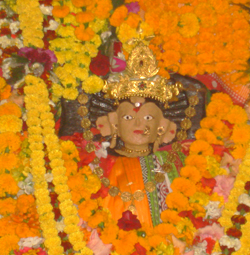 Candana Purṇimā -
On the Candan Purṇimā day in the month of may-June, the face of the deity of Goddess Biraja is smeared with sandal paste. So the day is very significant for the pilgrims. The Candana veśa of the Goddess attracts people form far and near to have a Darsan of the great mother Biraja.
Candana Purṇimā -
On the Candan Purṇimā day in the month of may-June, the face of the deity of Goddess Biraja is smeared with sandal paste. So the day is very significant for the pilgrims. The Candana veśa of the Goddess attracts people form far and near to have a Darsan of the great mother Biraja.
Sāvitri Amāvāsyā -
Sāvitri Amāvāsyā is exclusively celebrated on the new-moon day of the month of Jyestha (May-June). On this occasion there is a great rush in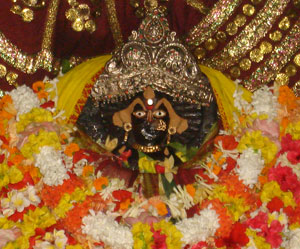 the temple premises specially married women come over here to worship Goddess Biraja for their unbroken conjugal happiness. As Goddess Biraja is regarded as Sāvitri they pray her for long-life of their husbands. They come with new-clothes and after worship break their fast taking different kinds of fruits.
the temple premises specially married women come over here to worship Goddess Biraja for their unbroken conjugal happiness. As Goddess Biraja is regarded as Sāvitri they pray her for long-life of their husbands. They come with new-clothes and after worship break their fast taking different kinds of fruits.
Citālāgi Amāvāsyā - Citālāgi Amāvāsyā is a special occasion celebrated in the month of Srāvaṇa (July-August). On this day the citā (a gold ornament for the fore head) is put on the fore head of Goddess Biraja after the due rituals citā (a special and aromatic cake) is offered to the Goddess.
Gahma Purṇimā - Gamha Purṇimā is otherwise known as Rākṣi Purṇimā that comes on the full moon day of Srāvaṇa (July-August). On this occasion special pūjā is held of the Goddess and she puts on Gold and silk band named Rākṣi on her left hand.
Suniā - Suniā marks the beginning of the Anka year of the Gajapati kings of puri and it also marks the beginning of the Autumnal Durgāpūjā festival in the Biraja temple. Goddess Biraja has been identified with Mahiṣāmardinī Durgā, So she is worshipped as Durgā at the time of autumnal festival Suniā is observed on the 12th day of the bright fortnight of the month of Bhādrapada (September), on this festive day after the traditional rituals the worship of lord Gaṇeśa and Goddess Saraśvatī is performed and the cutting of Gold (Svaraṇachedani) is held. Mangalārpaṇa (chanting of auspicious songs) work is performed before the Goddess. On this occasion the “Vanayāga” ceremony or Vilwa-Varana (worship of Vilwa tree) is observed for the construction of Simhadhvaja Ratha (chariot) that carries the deity during autumnal festivals. The construction of the said Ratha (chariot) starts form the day of Suniā.
Autumnal Durgā Pūjā - Autumnal worship of Goddess Durgā, the Mahiṣāmardinī is the most important festival near Goddess Biraja at Jajpur. This festival continues for a period of sixteen days starting form the 8th day of the dark fortnight of the month of Āsvina (September - October) and ending on the Mahānavami (9th day of the bright fortnight) day with much pomp and ceremony. Vedic and Tantric methods of worship are adopted for the great worship during the days of Mulāṣṭami (8th day of the dark fortnight) Pañcamī, Mahāṣṭamī, Mahānavamī and Daśharā (the 5th, 8th, 9th and 10th days of bright fortnight) the temple is over crowded by the devotees. This festival attracts pilgrims from all over Odisha and abroad.
Rathayātrā -
Rathayātrā or the car festival of Goddess Biraja is the most important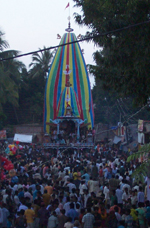 festival of Jajpur. During Durgā pūjā it is celebrated for nine days form the first day of the bright fortnight (Pratipada) of the month of Āśvina (September-October), the wooden chariot of Goddess Biraja is placed in front of the lion’s gate. After the traditional morning rituals the consecration work of the chariot named Simhadhvaja is held on the Pratiṣṭhā Maṇḍapa (an altar for consecration) after the yajna or sacrificial work is over, the representative deity of Goddess Biraja is ushered into the massive decorated chariot parked in front of the lion’s Gate in a special ceremonial procession arranged by the temple administration. The rhythmic clang of metal gongs, blowing of trumpets and devotionals chanting of the devotees fill the air. It is very interesting to know that a car festival for the Goddess is nowhere found in Odisha. We have such instances near Vindhyavāsinī and Sthambhesvarai in Madhya Pradesh and near Goddess Cāmuṇḍesvarī in Mysore, people from far and near come ever to Jajpur during the nine days car festival. The Ratha moves around the temple compound once a day for nine days continually. It is believed that one who perceives the Goddess on the Ratha is liberated form all sorts of sins.
festival of Jajpur. During Durgā pūjā it is celebrated for nine days form the first day of the bright fortnight (Pratipada) of the month of Āśvina (September-October), the wooden chariot of Goddess Biraja is placed in front of the lion’s gate. After the traditional morning rituals the consecration work of the chariot named Simhadhvaja is held on the Pratiṣṭhā Maṇḍapa (an altar for consecration) after the yajna or sacrificial work is over, the representative deity of Goddess Biraja is ushered into the massive decorated chariot parked in front of the lion’s Gate in a special ceremonial procession arranged by the temple administration. The rhythmic clang of metal gongs, blowing of trumpets and devotionals chanting of the devotees fill the air. It is very interesting to know that a car festival for the Goddess is nowhere found in Odisha. We have such instances near Vindhyavāsinī and Sthambhesvarai in Madhya Pradesh and near Goddess Cāmuṇḍesvarī in Mysore, people from far and near come ever to Jajpur during the nine days car festival. The Ratha moves around the temple compound once a day for nine days continually. It is believed that one who perceives the Goddess on the Ratha is liberated form all sorts of sins.
Lākhavindhā -
The Lākhavindhā (shooting of arrows) ceremony is held at the midnight of the Mahānavami day. The representative Goddess (Vije-pratimā) 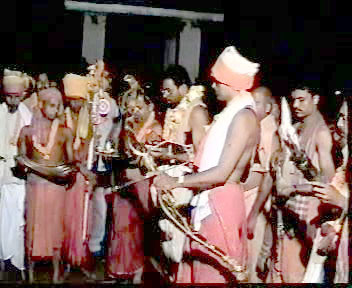 of the great mother Biraja descends from the chariot after nine days car festival and sets out towards Lākhavindhā ground (a specific place at the outskirts of the temple premises) in a Vimāna specially made for the purpose in a ceremonial procession. The Goddess is worshipped there as Mahāmārī. A Goddess named Lakṣesvari or Dākesvari near the ground is offered with a delicious and aromatic drink. After Pūjā rituals the pujaka throw arrows to four directions near a high pedestal. After this archery work the representative Goddess is brought back to the temple in a dark and soundless atmosphere. After a long period of nine days the Goddess is placed on the pedestal and the ceremony is declared over.
of the great mother Biraja descends from the chariot after nine days car festival and sets out towards Lākhavindhā ground (a specific place at the outskirts of the temple premises) in a Vimāna specially made for the purpose in a ceremonial procession. The Goddess is worshipped there as Mahāmārī. A Goddess named Lakṣesvari or Dākesvari near the ground is offered with a delicious and aromatic drink. After Pūjā rituals the pujaka throw arrows to four directions near a high pedestal. After this archery work the representative Goddess is brought back to the temple in a dark and soundless atmosphere. After a long period of nine days the Goddess is placed on the pedestal and the ceremony is declared over.
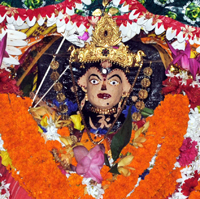 Kumāra Purṇimā -
Kumāra Purṇimā festival is observed on the full moon day of Āsvina (September-October). On this festival occasion the deity decorated with golden ornaments like a virgin. Cowry-play (Aksa) is held between the virgin Goddess and the chief priest. Khai or parched paddy is scattered on the entire ground in the temple premises special worship is held for the Goddess and it attracts large number of devotees in the evening.
Kumāra Purṇimā -
Kumāra Purṇimā festival is observed on the full moon day of Āsvina (September-October). On this festival occasion the deity decorated with golden ornaments like a virgin. Cowry-play (Aksa) is held between the virgin Goddess and the chief priest. Khai or parched paddy is scattered on the entire ground in the temple premises special worship is held for the Goddess and it attracts large number of devotees in the evening.
Dipāvali - On the eve of Kāli pūjā in the month of November, Dipāvali is celebrated with the lighting of several lamps. Special Tantric rituals are held near the Pārsva Devatā Ekapāda Bhairava and Cāmuṇḍa on the western side of the temple.
Prathamāṣṭami - It is a tradition is Odisha that or the day of Prathamāṣṭami in November, the eldest sons and daughters wear new clothes and takes a special and delicious cake with turmeric aroma named ‘Enḍurī’. Similarly Goddess Biraja is dressed with new clothes after due rituals and offered ‘Enḍurī’ (Steam boiled cake with the cover of turmeric leaf and prepared with rice paste, coconut, crystallized sugar or molasses, Ginger, cheese and camphor).
Dhanu Samkrānti - This is beginning of the month of Pauṣa (December-January) when people enjoy sweetened balls of parched and husked paddy for health. The same tradition is observed near Goddess Biraja with special worship and offering of sweetened balls of parched and hasked paddy.
Vakuḷa Amāvāsyā - On the new moon day of Pauṣa (Dec-Jan) Vakuḷa Amāvāsyā is celebrated in the Biraja temple. The goddess is offered with a special kind of cake named ‘Gaiṇṭha’ mixed with milk, sugar and mango inflorescence after the pūjā rites are held.
Apart from these specific festivals many other festivals are held inside the premises of the Biraja temple on certain particular occasions. Gaṇeśa pūjā on the 4th day of the bright fortnight of the month of Bhādrapada is held in a separate temple of lord Gaṇeśa inside the premises, on the day of Mahāviśuva Samkrānti special worship of Hanumān is held in the Hanumān temple. On the day of Mahāsivarātrī Rudrābhiseka and special worship of Lord Siva is held in the Isaneśvara temple. Including daily rites Bagalāmukhī is worshipped on special occasions is a modern temple inside the premises. Moreover Samkrānti, Amāvāsyā, Purṇami etc. are observed as the festive days of Goddess Biraja. On Saturdays and Tuesday’s homa or sacrifice is held with the recital saptasati candī or the devi mahātmya. The celebration of such festivals reveal that the people of Jajpur have kept the śākta tradition alive all along, which is the basic culture of Biraja Kṣetra along with other cultural aspects.
